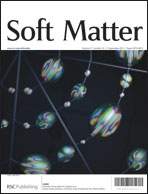Double network hydrogels prepared from pH-responsive doubly crosslinked microgels†
Abstract
Doubly crosslinked (DX) microgels are macroscopic hydrogels comprised of covalently inter-linked microgels. In this study pH-responsive DX microgels comprised of pH-responsive poly(ethylacrylate-co-methacrylic acid-co-1,4-butanediol diacrylate) (PEA-MAA-BDD) microgels were swollen with an acrylamide (AAm)/N,N′-methylenebisacrylamide (MBAAm) co-monomer solution which was copolymerised to give double network doubly crosslinked microgels (DN DX microgel). The DN DX microgels contained about 85 vol% of PAAm-co-MBAAm and 15 vol% DX microgel in the dry state. The DN DX microgels showed major improvements of their mechanical properties compared to the parent DX microgels and less pronounced pH-triggered swelling changes. The gel mechanical properties were investigated using dynamic rheology and compression stress vs. strain measurements. The new DN DX microgels had much improved shear and compression modulus (435 kPa), yield strains and toughness (105 kJ m−3) compared to the parent DX microgels. By improving both the modulus and ductility of our DX microgels, the double network approach offers improved potential for future application of DX microgels as implantable biomaterials in high load environments as well as membranes.


 Please wait while we load your content...
Please wait while we load your content...